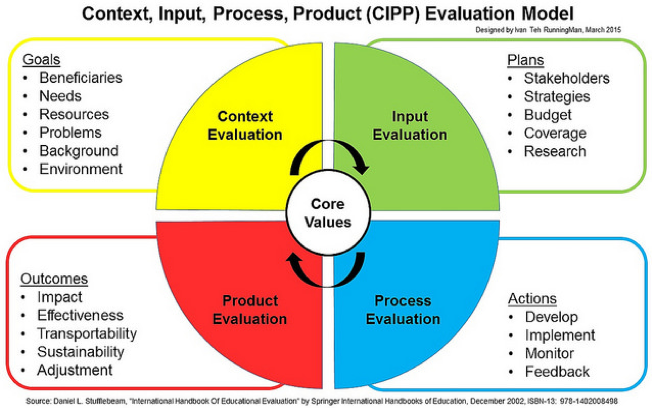Published – 28 August 2022 By Gavin Beever
This model is useful for those looking to improve program or project effectiveness. It does this by helping to identify strengths and limitations in delivery or in content. Effectiveness can then be improved by using the information gathered, to plan for better content and delivery in the future.
“The focus is on continuous improvement by concentrating on four areas of a program (or project): the overall goals or mission, (Context Evaluation); the plans and resources (Input Evaluation); the activities or components (Process Evaluation); and the outcomes or objectives (Product Evaluation).” – Yale Poorvu Center for Teaching and Learning

The evaluation flow is to move through each quadrant starting with Context Evaluation, then Input Evaluation, Process Evaluation and finishing with Product Evaluation. Very importantly, all stages of the evaluation are governed by the identified Core Values of the project or program.
The model was developed by Dr Daniel L. Stufflebeam, who was a distinguished professor emeritus at Western Michigan University and considered as one of the founding fathers of evaluation. The video below introduces Dr Stufflebeam and gives a good explanation of his CIIP model.
The CIIP model is a qualitative evaluation approach, such approaches gather information using the five senses and are subjective as compared to quantitative evaluation, which is about gathering hard data, facts and figures and is an objective approach.
A strength of following the approach is that evaluators can identify the key areas to focus ongoing evaluation upon, that ensures information and data is compiled, that can contribute to decision making around continuous improvement.
Further Information on Evaluation
Bennett’s Hierarchy Extension Program Evaluation Model
The Monitoring, Evaluation, Reporting and Improvement (MERI) Framework
Program Logic for Extension Project Planning
Continuous Business Improvement Model
Co-innovation a Way to Accelerate the Pace of Practice Change and Innovation
